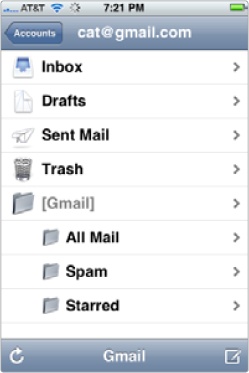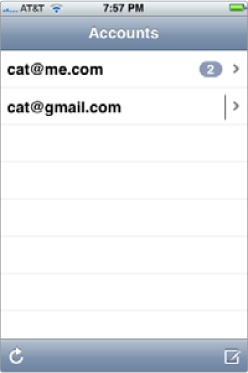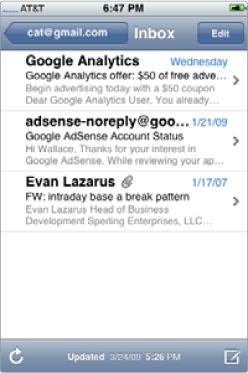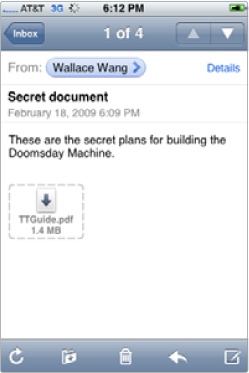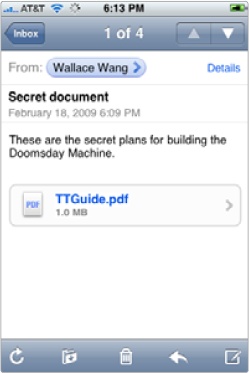Every email account consists of multiple folders, as shown in Figure 33-1:
To read individual messages, you need to choose the email account, the folder, and the specific message that you want to read.
Since you can set up multiple email accounts on your iPhone, you may need to choose which email account to use by doing this:
From the Home screen, tap Mail. The number of unread email messages appears as a white number inside a red circle at the upper-right corner of the Mail icon at the bottom of the screen, as shown in Figure 33-2.
(Optional) If a specific email account screen appears (see Figure 33-1), tap Accounts in the upper-left corner of the screen. The Accounts screen appears, as shown in Figure 33-3.
Tap the account you want to use.
Once you've selected an email account, your next step is to select a folder (most likely the Inbox folder) and a message in that folder to read. To read an email message, do this:
Follow the steps in the section Choosing an Email Account to display the folders of an account.
Tap a folder, such as the Inbox folder. A list of stored messages appears, as shown in Figure 33-4.
Tap a message that you want to read. The message appears on the screen.
Many people send files attached to an email message. If you receive a message with a file attachment, a paper clip icon appears next to the sender's name (see Figure 33-4). Unlike a regular computer, your iPhone can open and display only a limited number of file types, including Microsoft Word and Excel files, text files, PDF (Adobe Acrobat) files, and HTML (web) files.
Since file attachments can be large, your iPhone won't waste time downloading them until you specifically ask it to do so. To view a file attachment, do this:
Follow the steps in the section Choosing a Folder and a Message to display a list of messages in an account.
Tap a message that contains a file attachment (a message that displays the paper clip icon next to the sender's name). The message appears with a downward-pointing arrow icon that represents your file attachment, as shown in Figure 33-5.
Tap the file attachment icion to download it. After the file is downloaded, the file attachment icon changes its appearance, as shown in Figure 33-6.
Tap the file attachment icon to display it. You may need to scroll up and down to view the contents of the entire file. To view the original message that came with the file attachment, tap Message in the upper-left corner of the screen.

